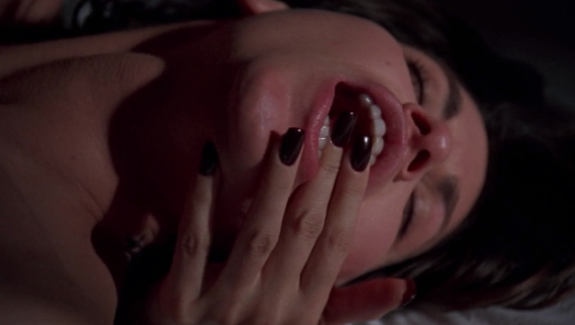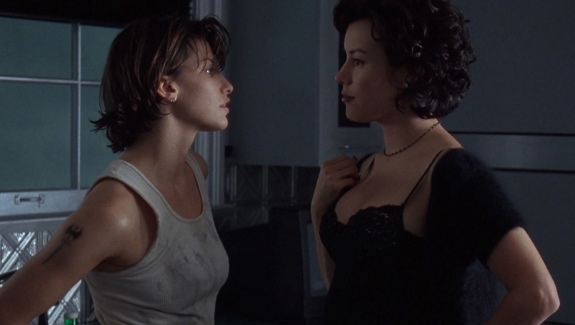
Over the course of seven films and one TV series, directors Lana and Lilly Wachowski have proven to be experts at smuggling cultural theory into commercially successful films. Take their 1999 blockbuster, The Matrix: inspired by the work of Jean Baudrillard, it features Neo (Keanu Reeves) using a hollowed-out copy of the French philosopher’s Simulacra & Simulation as a secret hiding place. But such sly, savvy moves have been present in the Wachowskis’ work since their first film: the cult lesbian noir Bound (1996), which applies elements of queer theory to the femme fatale archetype. Starring Jennifer Tilly as Violet, a coquettish mob doll who teams up with her tool-belt toting lover Corky (Gina Gershon) to rob her Mafioso boyfriend, this queer neo-noir harnesses and inverts harmful narratives that view queerness as the natural enemy of the family unit and punish the fatale for daring to manipulate her own image.
Feminist film theory has long been fascinated with the femme fatale archetype as a deeply misogynistic projection of anxieties around femininity and female sexuality that paradoxically allows women characters to demonstrate a level of personal and sexual agency uncommon in Hollywood films. In clarifying Violet’s queerness in Bound, the Wachowskis perform the revisionary labour (described by José Muñoz in Disidentifications) of working “on and against” the dominant ideology,[i] thereby allowing Violet to transcend the narrative constraints that so tightly bound her foremothers.
Within these constraints, the femmes fatales of the classic noir period (roughly the early 1940s to late 1950s) expressed nascent (if heavily coded) strains of queerness. Homosexuality in 1940s America was widely perceived as a sexual inversion: lesbians were viewed as women with masculine souls. With this in mind, the queer connotations of the 1944 noir Double Indemnity become apparent: Phyllis Dietrichson (Barbara Stanwyck) appears hyper-feminine in soft sweaters and frilly blouses, until Walter Neff (Fred MacMurray) uncovers her urge to dominate and her successful trespass into the “masculine” realms of crime and economics.
A fearful spectre of women’s power, the fatale tends to rear her head during periods of anxiety about (often white, middle class) gender roles: the classic noir era took root as soldiers returned from World War II to find that many women intended to keep the jobs they had taken up out of necessity during the war. Fifty years later, as third-wave feminism and AIDS-era queer activism once again challenged heteronormative notions of sexual difference, the femme fatale re-emerged as an icon in 1990s neo-noir erotic thrillers. Influenced by the explosion of pornography that rocked the 1980s (resulting from the new, widespread availability of home video technology), neo-noirs combined soft-core pornographic visual codes (soft focus and warm lighting to imitate candlelight) and sequences of extended sexual spectacle with detective storylines. The femme fatale’s once heavily coded queerness was openly declared by neo-fatales in scenes that would have given even Phyllis Dietrichson’s rotten heart palpitations, such as the memorable shot of Basic Instinct’s (1992) sexy-scary, “aggressively flexible” Catherine Tramell (Sharon Stone) cupping her female lover Roxy’s breast through a see-through mesh top.[ii]

Yet, in the tradition of soft-core pornography, Catherine’s queerness is a spectacle for male consumption. Detective Nick Curran (Michael Douglas) stands in for the presumed male viewer, making eye contact with Catherine whenever she touches Roxy. Just as Phyllis methodically eliminates the Dietrichson clan (killing her husband and his first wife, and attempting to have their daughter killed), Catherine and all of her female lovers have murdered members of their families, as though Catherine’s explicit queerness has infected every woman in the film. Basic Instinct makes the familiar insinuation that homosexuality is a contagious disease, and that lesbians are dangerous to men and families alike.
Emerging at the tail end of the 1990s neo-noir era, Bound reorients this homophobic angst by replacing the fatale’s threat of violence to the family with recognition of the violence of the family—or, in this instance, “the family.” In substituting the mafia for the more literal nuclear families of past noirs, male supremacy’s dependence on the heteropatriarchal family unit is made explicit. Bound’s “family” is a male-centric sphere that keeps men’s pockets full and relies on violent policing to ensure its futurity. After an employee named Shelly skims roughly $2.1 million off of their profits, the family cuts his fingers off, one by one, with pliers; Violet will later narrowly avoid the same fate.
Excluded from a family of fathers and brothers, the women of Bound are left with limited options for accessing capital. Violet represents one available avenue, depending on her relationship with her boyfriend Caesar for financial security. Corky, who seeks to separate herself as cleanly as possible from the family by virtue of her out-lesbian status (signaled by her overtly butch appearance), still can’t avoid economic implication with the mob; upon meeting her, Caesar stuffs money into Corky’s hand and tells her, “Welcome to the family.” While Corky’s approach gives her slightly more freedom than Violet’s, it’s also not without risks. Lacking the protection of an established criminal syndicate, Corky is more vulnerable to arrest. At the start of the film, she’s just been released from a five-year stint in prison for, as she puts it, “the redistribution of wealth.” As Kelly Oliver and Benigno Trigo have pointed out in “Make it Real: Bound’s Way Out,” it’s no coincidence that Corky’s prison sentence and Violet’s relationship with Caesar have each lasted five years.[iii] Life for women under the patriarchy has always been a series of compromises and trade-offs. As Violet tells Corky: “We make our own choices, we pay our own prices. I think we’re more alike than you care to admit.”

While the fatale’s family-murdering tendencies typically elicit intense anxiety in film noir’s male protagonists (and thus, its audiences), Bound’s female protagonists recognize that destroying the heteropatriarchy is their only path to freedom. In keeping with politically negative queer theory like Lee Edelman’s No Future,[vi] the film finds a glorious retribution in confirming associations between homosexuality and the death of the family.
Given the hotbox of competing masculinities that make up Bound’s mafia, it’s shocking that the organization needs any help to implode on itself. No one is more privy to the shortcomings of normative masculinity than Violet, who is regularly hit on by every member of the family in order to puff up their egos and denigrate her boyfriend—their attention merely reflects Violet’s status as phallus, something they can take from Caesar to prove their dominance. After the mob boss’s son, Johnny, explodes with rage against Shelly and soaks the stolen money in blood, Caesar the money launderer is, ironically, forced to individually wash and iron thousands of dollars. It’s the perfect moment for the women to steal the money and wait for Caesar’s temper—already riled from being thrust into a domestic role—to get him into trouble. A feasible plan, so long as Caesar continues to believe that Violet is under his control.
Bound’s female protagonists recognize that destroying the heteropatriarchy is their only path to freedom
Classically framed as a male detective investigating the nature of sexual difference by way of the femme fatale, film noir obsesses over the politics of seeing and being seen. With her ability to segregate artifice from intention and image from self, the fatale is irresistible to many feminists because she is living, preening proof that the male gaze can be manipulated. As Oliver and Trigo have argued, the strength of Corky and Violet’s plan derives from their exploitation of men’s inability to see past their own grotesque stereotype of Violet as a docile sex kitten.[v] Corky reassures Violet, “If you’re real enough, he’s gonna believe you. Because deep down, he’ll want to.”
Following pornography’s lead, neo-noir invests the sex act with anxieties over the limitations of what can be seen, and therefore known, about women. In her study of 1980s pornography, Linda Williams writes, “although the genre as a whole seems to be engaged in a quest for incontrovertible ‘moving’ visual evidence of sexual pleasure in general, and women’s pleasure in particular, this is precisely what hard core could never guarantee.”[vi] While ejaculate serves as evidence of male orgasm, the female orgasm is being (successfully) faked somewhere in the world at any given moment. In Basic Instinct, this desperation to know reveals itself through the immense degree of sexual frustration generated as Nick repeatedly butts up against the limits of the visible. In one of the most over-the-top scenes in the film, Catherine uncrosses her legs to reveal a lack of underwear during an interrogation of her sadomasochistic tendencies by a row of pasty detectives. But there is no truth to be found in the flash of Sharon Stone’s snatch, nor does Nick succeed in fucking a confession out of Catherine.
While Basic Instinct is preoccupied by the fear that sexual performance may indeed be just a performance, Bound ultimately finds a profound power in Violet’s ability to deceive men both socially and sexually. Chris Straayer discerns that the film puts “pro-sex lesbian discourse and lesbian feminism in dialogue,”[vii] and the central couple’s only major dispute arises when Corky accuses Violet of not being a “real lesbian” because she has sex with men. Refusing to be shamed for what she considers work—she explains that her arrangement with Caesar is an extension of her sex work, comparing their relationship to a rental agreement—Violet articulates a queer understanding of sexuality that holds that the sex act is first and foremost an act, separable from one’s personal sexual identity. Decentering vision as the only path to knowledge, Violet offers her wetness as proof, purring to Corky, “you can’t believe what you see, but you can believe what you feel.”
Ultimately, Corky abandons her narrow definition of lesbianism in favour of Violet’s perspective, ditching conventional noir detectives’ consuming obsession with sight in the process. Her reward for trusting Violet is a loving partner and two million dollars. The two women ride off into the sunset, not on a horse but in a brand new red pickup truck purchased with the mafia’s money, perfectly encapsulating José Muñoz’s vision of queer futurity through a powerful image of a queer utopia.




